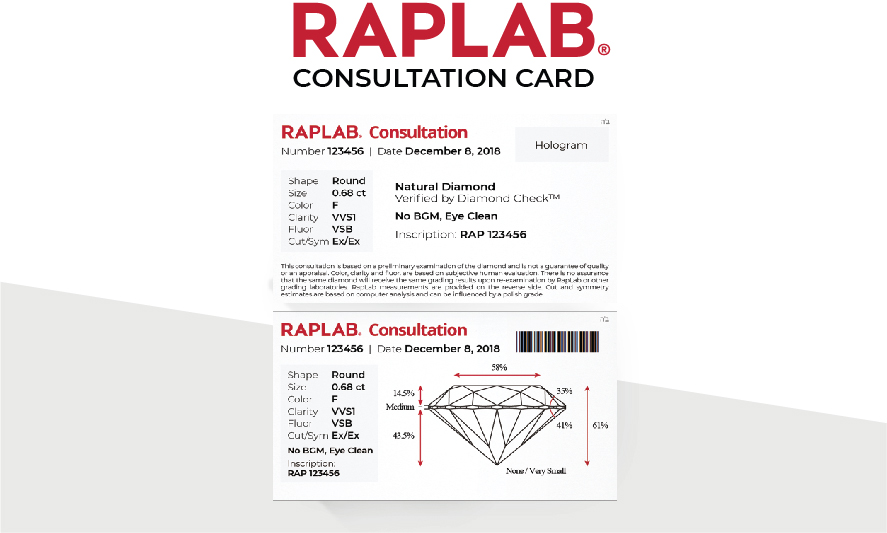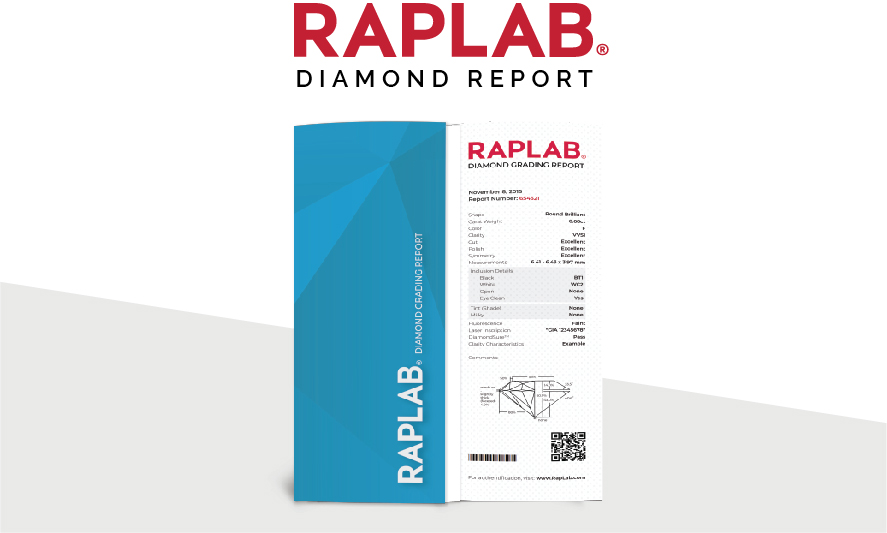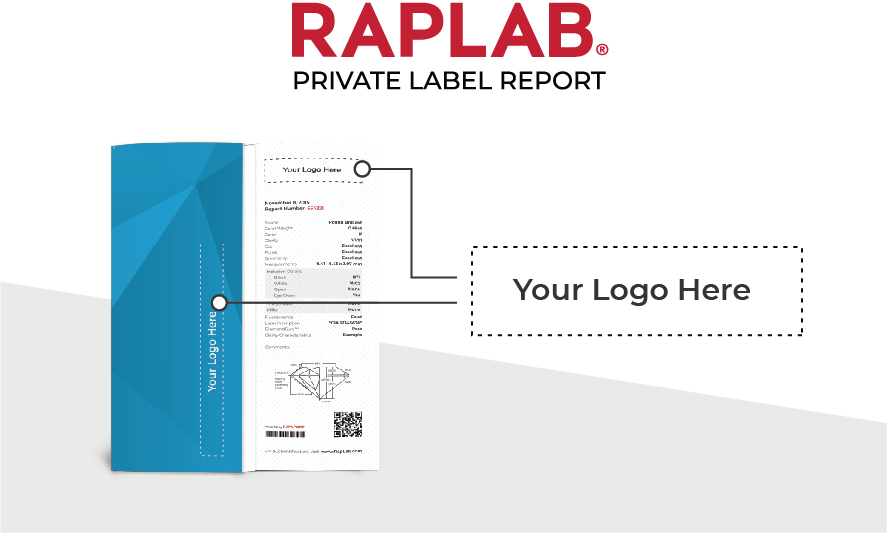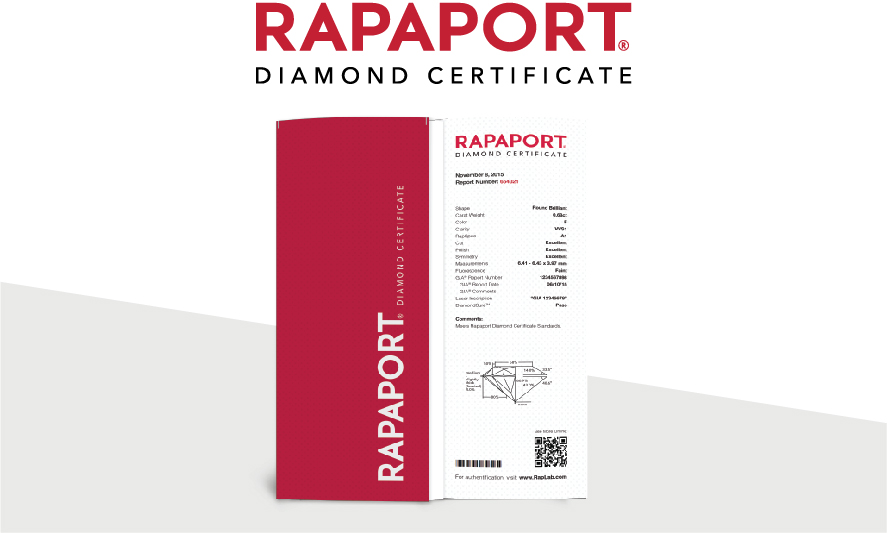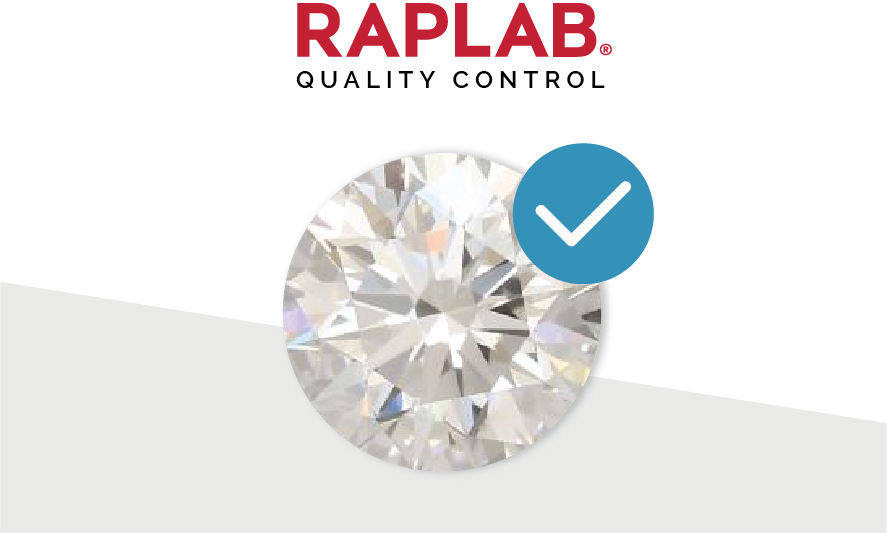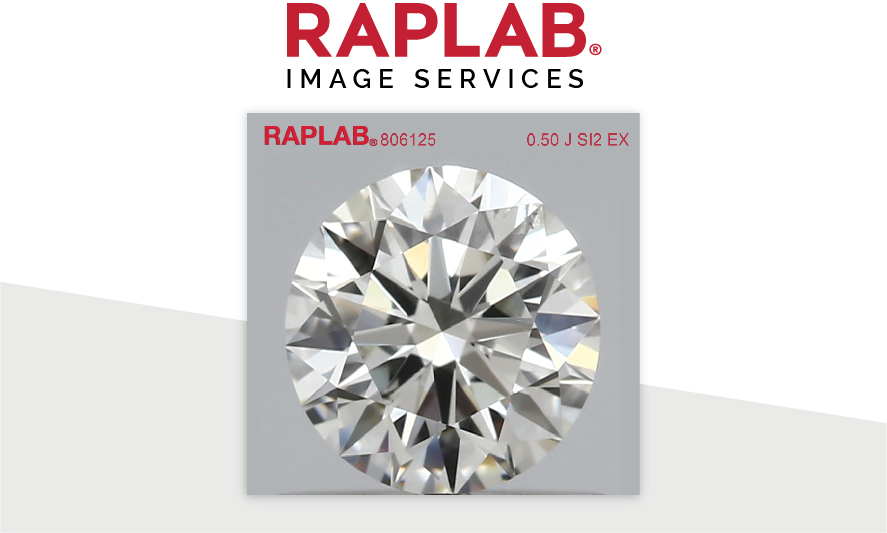Homepage2
RAPLAB® SERVICES
RAPLAB® offers our clients the expertise, convenience and technological sophistication of our Rapaport diamond grading laboratory. Our gemological laboratory efficiently and securely evaluates the quality of your diamonds using the latest technology. Online access to verify reports and high definition images are provided.
VERIFY RAPLAB REPORT
RAPLAB® SERVICES
Buy and Sell with Confidence
The RapLab Diamond Grading Report (RGR™) provides a full range of detailed gemological information including BGM, Color Shade, EyeClean, Type and Location of Inclusion, Video and Photo Imaging. All reports are fully digitalized and easily uploaded to RapNet with special “RapNet Verified” designation. Includes a fine quality print report and everything you need
to trade over the internet.
Submit Your Diamonds
RapLab® clients can submit diamonds for grading via Rapaport Offices in New York, Ramat Gan, Antwerp, Mumbai, Surat and Hong Kong.
Education
The 4 C’s are part of a well-known grading system for evaluating diamonds by grading the carat weight, color, clarity and cut.
CONTACT US
SUBMIT DIAMONDS
SENDING YOUR DIAMONDS TO RAPLAB®
Please follow these three simple steps:
1. Register With RapLab®
Complete the Client Agreement and email it to [email protected] or send a hard copy to your local RapLab® office. Upon approval, you will be contacted by a customer service representative who will assist you in setting up your RapLab® account. You will then, be provided with a unique RapLab® client number and login/password. Please note, all RapLab® clients must be registered and sign our Client Agreement.
2. List Your Diamonds
Complete the Submission Form by listing the diamonds you wish to send RapLab. We advise you to email an Excel file list of these diamonds to [email protected].
3. Package and Ship Your Diamonds
Please remember to always include the Submission Form when sending your diamonds to RapLab®. Each diamond should be in its own individual parcel paper highlighting the carat weight. Please do not provide information identifying yourself or your company on the diamond parcel papers.
Diamonds may be delivered or shipped directly to our Ramat Gan, Mumbai or Surat offices. Clients may also submit diamonds via our local offices in New York, Antwerp, or Hong Kong. Please note shipping charges may apply for some locations.
International & Israel
RapLab Ramat Gan
Rapaport Gemological Laboratories Ltd.,
13th Floor – suite 1362, Tuval 21,
Ramat Gan, Israel 52521 P.O.B 101.
Tel: +972-3-613-3330.
India
RapLab Mumbai – Rapaport
Rapaport India
101, The Capital, Plot No C-70,
BKC, Bandra East, Mumbai – 400 051
Tel: +91-22-6628-6500
RapLab Surat – Rapaport
501-504 C Wing Diamond
World Building Mini Bazar
Mangadh Chowk, Varachha Road
Surat 395 006, India
Tel: +91-261-672 3309
RAP SPECS A1
RAPAPORT DIAMOND SPECIFICATIONS - A1 + A2
| A1 | A2 | |
| Grading Report | GIA | GIA |
| Shape | Round Brilliant | Round Brilliant |
| Cut | Excellent | Excellent |
| Polish | Excellent | Excellent |
| Symmetry | Excellent | Excellent |
| Culet | None | None |
| Depth % | 59.0 - 62.9% | 59.0 - 62.9% |
| Table % | 56 - 60% | 55 - 60% |
| Girdle | No Extremely Thin, Extremely Thick or Very Thick | No Extremely Thin, Extremely Thick or Very Thick |
| Fluorescence | None | None |
| Weight | No .00 sizes for 1.00 and larger | No .00 sizes for 1.00 and larger |
| GIA Comments | No GIA Color Comment | No GIA Color Comment |
| GIA Comments | No Knot or Cavity | No Knot or Cavity |
| GIA Comments | No Extra Facet or Natural for D-H, IF-VVS2 | No Extra Facet or Natural for D-H, IF-VVS2 |
| GIA Comments | No Graining Comment IF-VS2 | No Graining Comment IF-VS2 |
| GIA Comments | For SI1 or lower No "clarity based on cloud" | For SI1 or lower No "clarity based on cloud" |
| Seller Requirement | No tint, "grademaker center black" or open inclusions | No tint, "grademaker center black" or open inclusions |
| Seller Requirement | EyeClean: SI2+ to 3.99ct, SI1+ to 4.99, VS2+ all sizes | EyeClean: SI2+ to 3.99ct, SI1+ to 4.99, VS2+ all sizes |
| Seller Requirement | No Marange Diamonds | No Marange Diamonds |
MINIMUM MILLIMETERS
| Size ct. | Min mm |
| 0.50 - 0.59 | 5.05 |
| 0.60 - 0.69 | 5.35 |
| 0.70 - 0.79 | 5.65 |
| 0.80 - 0.89 | 5.90 |
| 0.90 - 0.99 | 6.15 |
| 1.01 - 1.09 | 6.40 |
| 1.10 - 1.24 | 6.55 |
| 1.25 - 1.49 | 6.85 |
| Size ct. | Min mm |
| 1.50 - 1.69 | 7.30 |
| 1.70 - 1.99 | 7.60 |
| 2.01 - 2.49 | 8.05 |
| 2.50 - 2.99 | 8.60 |
| 3.01 - 3.49 | 9.15 |
| 3.50 - 3.99 | 9.62 |
| 4.01 - 4.99 | 10.05 |
| 5.01 - 5.99 | 11.00 |
FLUORESCENCE
RAPLAB® GRADING CRITERIA
The 4 C’s are part of a well-known grading system for evaluating diamonds by grading the carat weight, color, clarity and cut. RAPLAB® grades diamonds based on the 4 C’s and several additional criteria using sophisticated technology to provide you with a more detailed and informative certification.
FLUORESCENCE
One diamond out of three responds with fluorescence glow if exposed to ultraviolet (UV) rays. The strength, intensity and color of the fluorescence are different for each stone. Just 10 percent of all stones have a steady, strong fluorescence.
Usually, the fluorescence color is blue, though occasionally it is yellow or white. Rare fluorescence colors, like: orange, purple and red. can be found in a very unusual stones.
RAPLAB® gemologists grade fluorescence in order to evaluate its glowing strength and intensity and describe its color, if it has any.

FLUORESCENCE GRADING SCALES ARE:
Keep in mind that fluorescence does not affect the stone’s beauty, clarity or structure. Research has not found any connection between the presence of fluorescence and a weak diamond. A few diamonds with enormously strong fluorescence may have a milky or oily appearance.
This is a unique attribute of some diamonds that causes them to “glow” a typically bluish color when exposed to natural or man-made ultraviolet light (like a Black Light). About 50% of all diamonds fluoresce and of those about 10% fluoresce strongly. Most of the time, fluorescence is not a factor unless the intensity is Strong or Very Strong. In the very rare colors D, E, and F, Strong fluorescence stones are consider less desirable. However, in the less rare colors of such as J – K and below, Strong fluorescence may be desirable.
BLUE-WHITE
This is a false and misleading term. According to the FTC a diamond must be blue/bluish or colorless. Fluorescence is also a factor. AGS prohibits use of the term.
TREATMENTS
RAPLAB® GRADING CRITERIA
The 4 C’s are part of a well-known grading system for evaluating diamonds by grading the carat weight, color, clarity and cut. RAPLAB® grades diamonds based on the 4 C’s and several additional criteria using sophisticated technology to provide you with a more detailed and informative certification.
TREATMENTS
Various ways of “treating” a diamond, such as heat, can be used to enhance the colorlessness of a diamond or intensify the color of fancy colored diamonds. The results of these treatments can produce temporary or permanent results. However, treated stones are worth far less per carat than natural stones.
HPHT
High Pressure-High Temperature (HPHT) is a process that applies extreme pressure —approximately 850,000 pounds per square inch — and very high temperature — of about 1,600 degrees centigrade — to the diamond. By altering the molecular structure of natural diamonds, HPHT greatly enhances their color. Only certain types of diamonds can be affected by this treatment, which can turn a brown diamond colorless.
CHEMICAL VAPOR DEPOSITION (CVD)
This is the most popular method of making synthetic diamonds. Carbon gases are broken down in a chamber and turned into solid crystals. Controlling the temperature, types of gases and amount of pressure in the process can create different types of diamonds.
LASER DRILLING
Lasers are used to minimize the appearance of flaws and make them less visible. The results of laser drilling are permanent. Drilling does leave colorless cavities in the diamond.
IRRADIATION
The irradiation of diamonds can result in the production of fancy colored stones, especially blues, greens and deep yellow. Radiation may also be used to reduce the flaws on a diamond.
PAINTING
This process involves painting a very thin coat of a chemical substance over the entire stone, or part of it, to improve the color. Painting neutralizes the yellow in the stone and can improve the color by as much as seven grades.
SHAPE
RAPLAB® GRADING CRITERIA
The 4 C’s are part of a well-known grading system for evaluating diamonds by grading the carat weight, color, clarity and cut. RAPLAB® grades diamonds based on the 4 C’s and several additional criteria using sophisticated technology to provide you with a more detailed and informative certification.
There are nearly 2,000 different diamond shapes, with the round brilliant cut being most common.
ROUND, STANDARD, BRILLIANT CUT
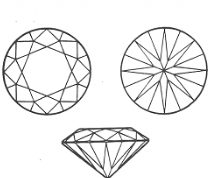
RECTANGULAR, STANDARD, STEP CUT
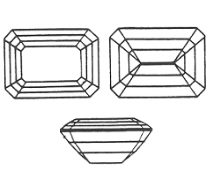
DIAMOND SHAPES
Today, there are eight traditional brilliant cuts:
-
- Round (RB )
- Cushion(CB)
- Heart (HB)
- Marquise (MR)
- Oval (OV)
- Pear (PS)
- Rectangular
- Square (SQ)
There are other shapes as well; the most familiar are:
- Emerald (EM)
- Radiant (RD)
- Princess (PR)
- Triangular (TR)
SYMMETRY
RAPLAB® GRADING CRITERIA
The 4 C’s are part of a well-known grading system for evaluating diamonds by grading the carat weight, color, clarity and cut. RAPLAB® grades diamonds based on the 4 C’s and several additional criteria using sophisticated technology to provide you with a more detailed and informative certification.
SYMMETRY
Symmetry refers to the exactness of the shape and arrangement of facets in a diamond. Although to the naked eye polish has only a small effect on appearance, symmetry has a significant effect.
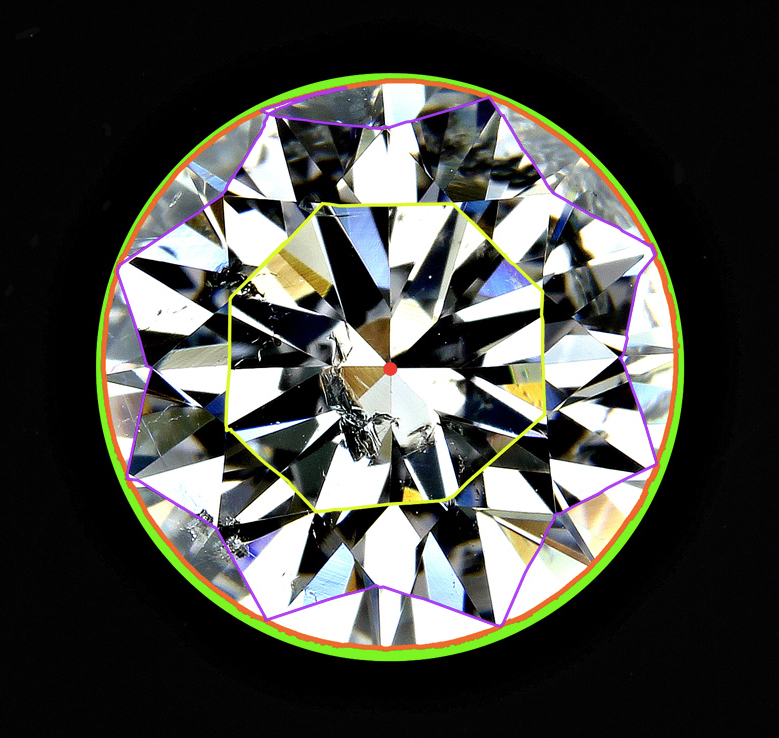
Green – perfect round
Orange – the stone Out of round
Purple – Misshapen Facets
Yellow – None octagonal table
Red – Culet Off-Center
Yellow + Red – Table Off-Center & Table & Girdle Misalignment
Crown & Pavilion Misalignment – In a round diamond the top points of the pavilion mains and the bottom points of the bezel facets should meet precisely at the girdle.
Table & Girdle Misalignment – – the table is not parallel with the girdle. As you see, the crown angle is much steeper on one-side versus the other. From the top view you may have noticed an off-center table.
Misshapen Facet – A correct table displays a regular octagonal shape. It should have eight sides of equal length that are each parallel to the opposing opposite facet. In this example we see facets that are not the same size and shape as others like them on the face of the diamond.
T/OC Table Off–Center The placement of the table (the largest facet on a diamond) should be centered at the top of the stone and needs to be parallel to the girdle. If the table is off-center or not parallel with the girdle this can cause uneven crown angles from one side to the other.
C/OC Culet Off-Center – To check if the culet is centered look at the diamond in the face-up position. You’ll see the lower girdle facets through the table. If the lines formed by them look like a perfect square, the culet is centered. If the cross bends one way or the other, the culet is not centered. In this example we see what an off-centered culet might look like
Extra Facets -These are typically located on the pavilion, near the girdle, but they can be found anywhere on a diamond. In this example we see where extra facets commonly occur.
Crown Height verification– Contrary crown height measurement may indicate about a wavy girdle or crown – pavilion misalignment.
Crown angel verification – Unequal crown angel measurement may indicate a wavy girdle or crown – pavilion misalignment.
Pavilion Depth verification – dissimilarities in pavilion depth is a sign of a wavy girdle.
Pavilion angel verification – Differing crown angel indicate for culet of center (COC).
Wavy Girdle – The girdle of a diamond should be a flat plane, parallel to the table. In this example the girdle “waves” as it wraps
around the diamond.
Faces not Pointing Up – Some diamonds display facets that are not properly pointed. Facet patterns of round brilliants are meant to show a precise arrangement of 58 perfectly shaped facets. In this example we see some that some do not meet at a direct point.
Naturals on Crown and Pavilion – A natural is the original “rough” of the diamond. Naturals always occur or start out on the girdle. They either dip towards the pavilion or the crown. In this example we see the natural located on the girdle running down into the pavilion.
POLISH
RAPLAB® GRADING CRITERIA
The 4 C’s are part of a well-known grading system for evaluating diamonds by grading the carat weight, color, clarity and cut. RAPLAB® grades diamonds based on the 4 C’s and several additional criteria using sophisticated technology to provide you with a more detailed and informative certification.
POLISH
The quality of a diamond’s polish can affect the way light enters and is refracted from the stone. Polishing removes unwanted material by gradual erosion. After polishing, the diamond is re-examined for possible flaws, either remaining or induced by the polishing process.
This characteristic refers to the finishing or final polishing of the facets, or flat surfaces. Each facet should be carefully fashioned by the diamond cutter to shine and be free from polishing imperfections that can dull the diamond. The polish of a diamond is generally defined as: Poor, Fair, Good, Very Good, or Excellent. When purchasing a diamond, generally the rarer color and clarity diamonds are also well polished. Contrary to common belief, diamonds are ground and polished, not chipped away, until they reach their final form.
CUT
RAPLAB® GRADING CRITERIA
The 4 C’s are part of a well-known grading system for evaluating diamonds by grading the carat weight, color, clarity and cut. RAPLAB® grades diamonds based on the 4 C’s and several additional criteria using sophisticated technology to provide you with a more detailed and informative certification.
Cut identify how closely the diamond has been cut and polished to ideal proportions.
A diamond’s cut is not only about its shape, but how effectively the stone can return light back to the viewer’s eye. A well-cut diamond will be seen as brilliant and sparkling. A poorly cut diamond may have the highest color and perfect clarity yet it will look dark and lifeless.
Not only do well-cut diamonds appear more brilliant, they can also appear larger than other stones of the same carat weight. An ideal stone has both increased brilliance as well as increased diameter relative to more deeply cut diamonds.
THE PATH OF LIGHT IN 3 DIFFERENTLY PROPORTIONED DIAMONDS
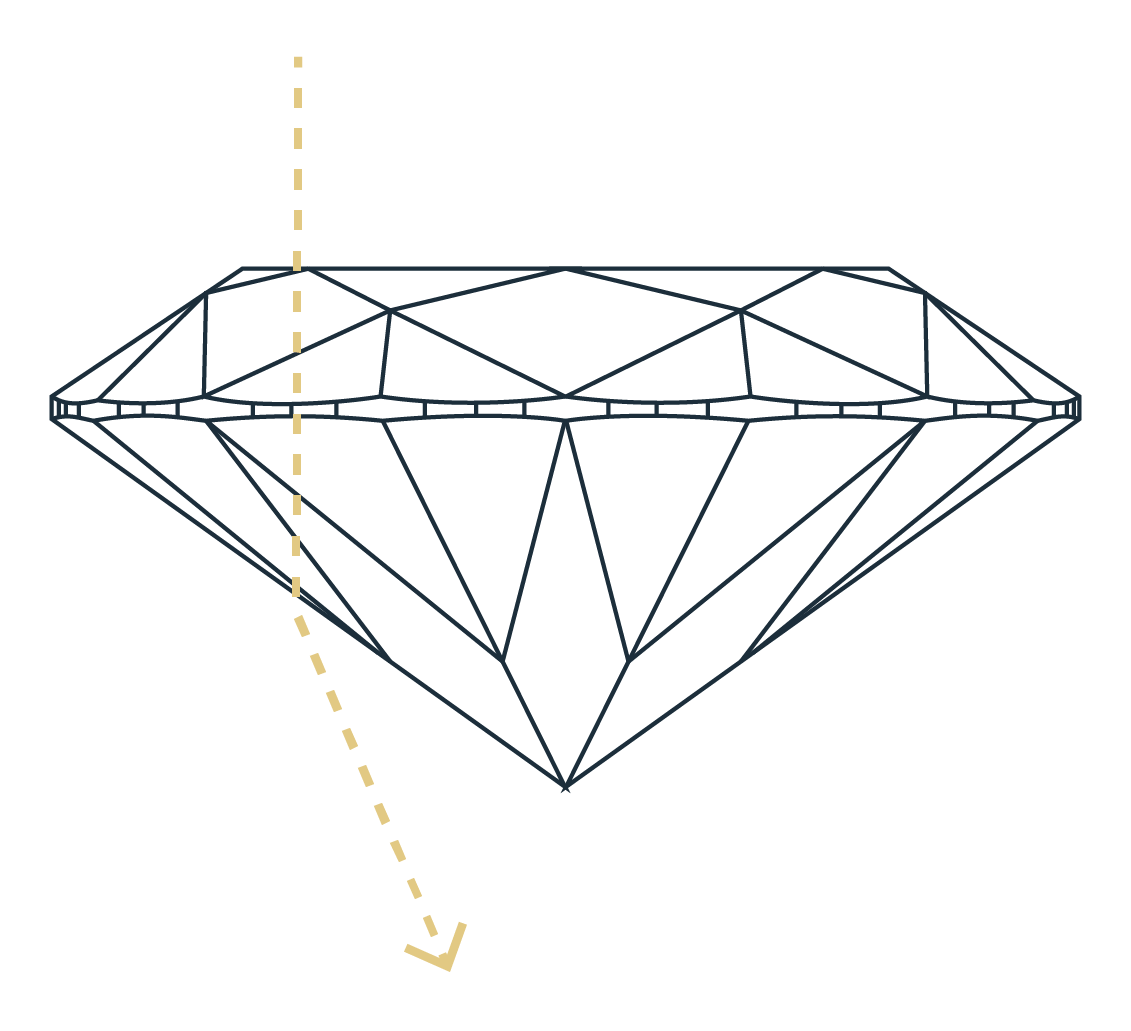
"SHALLOW-CUT" DIAMOND
Much light leaks out of the pavilion causing the diamond to appear "washed-out", or "watery"
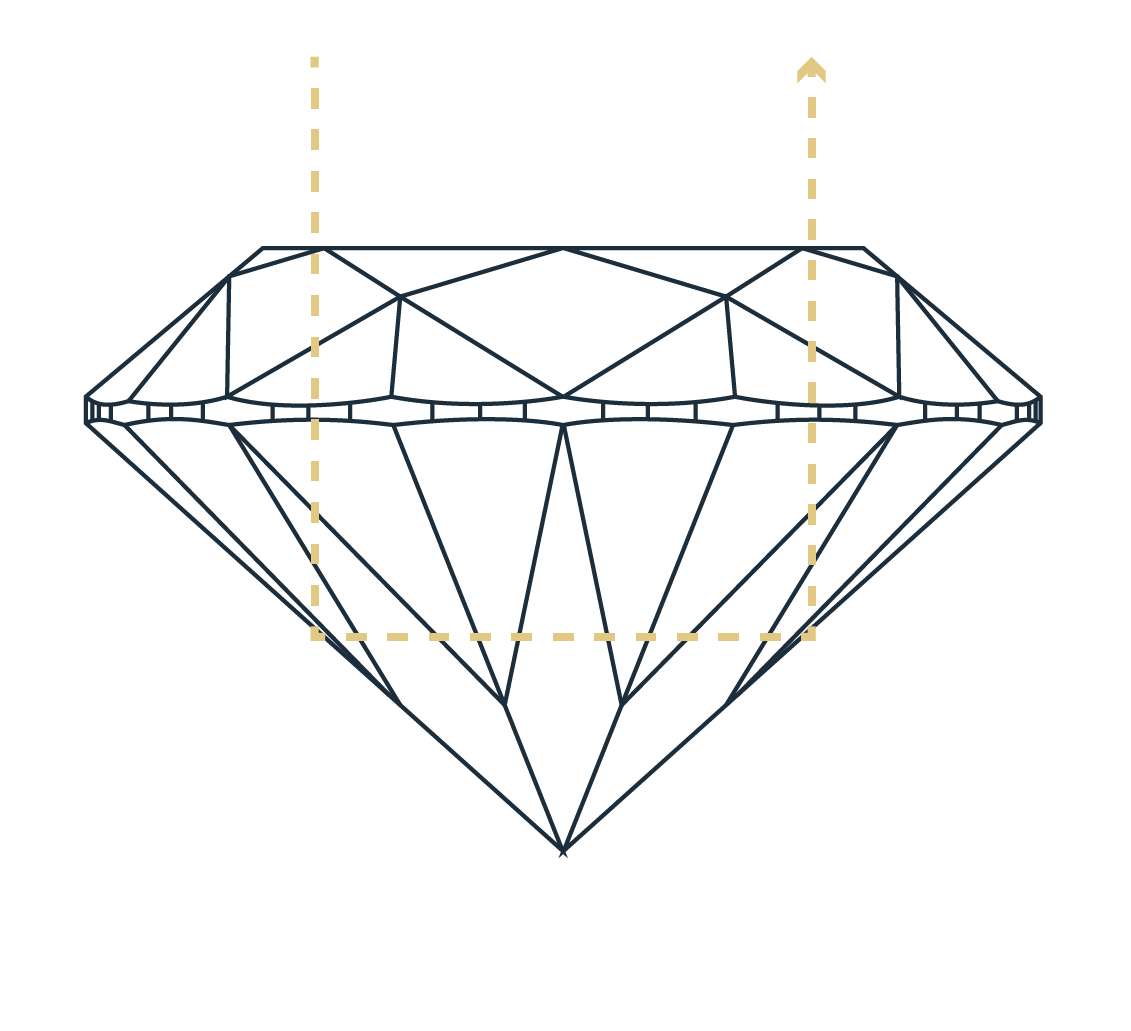
"WELL-CUT" DIAMOND
The Majority of light returns to the eye exhibiting a Balance of Brilliance, Dispersion, Scintillation and Luster
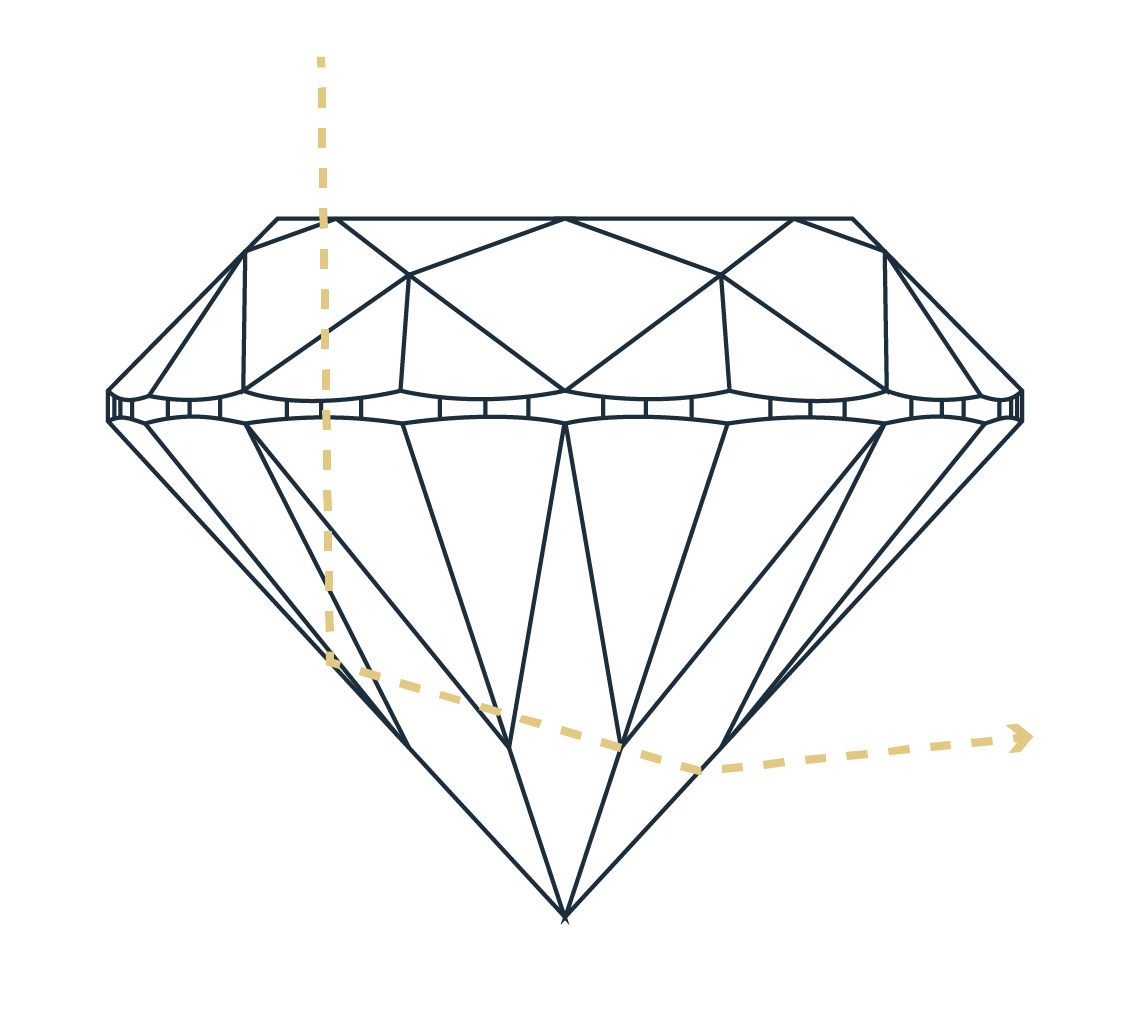
"DEEP-CUT" DIAMOND
Much light leaks out of the pavilion causing the diamond to appear dark. Extreme examples are called "Nail-heads"
When a diamond is cut to the proper proportions and is finished well, light refracts into the diamond, is reflected from one facet to another and then returns through the top of the gem resulting in a display of brilliance (white light), dispersion (rainbow-colored light) and scintillation (sparkling when the diamond moves), and luster (bright reflections from the surface). Proper cutting is the key to a diamond’s beauty and value.
Most diamond shapes are cut with 58 facets, or separate flat surfaces, according to mathematical formulas. Using symmetry, the cutter aligns these facets at precise angles in relation to each other to maximize the reflection and refraction of light.
The proportions are calculated in angles & percentages that show how well the diamond refracts and reflects light.
A DIAMOND’S ANATOMY

Crown
The area of the diamond above the girdle
Girdle
The girdle is the outer edge of the diamond. It is rated in terms of thickness ranging from thin to thick: Extremely Thin, Very Thin, Thin, Medium, Slightly Thick, Thick, Very Thick, or Extremely Thick. When purchasing a diamond, avoid Extremely Thin or Extremely Thick. The girdle usually has a frosted appearance. Many diamonds are also finished with a fully polished or even a faceted girdle, depending on the cutter’s preference. This will not affect the diamond’s value.
Pavilion
The bottom part from the girdle to the culet.
Culet
The culet is the bottom point of the diamond. In many cases, this point actually has a very small facet. The culet is graded according to the presence or size of this facet: None or Pointed, Very Small, Small, Medium, Slightly Large, Large, Very Large and Extremely Large. The more desirable culets are graded from none to small
Polish
This characteristic refers to the finishing or final polishing of the facets, or flat surfaces. Each facet should be carefully fashioned by the diamond cutter to shine and be free from polishing imperfections that can dull the diamond. The polish of a diamond is generally defined as: Poor, Fair, Good, Very Good, or Excellent. When purchasing a diamond, generally the rarer color and clarity diamonds are also well polished. Contrary to common belief, diamonds are ground and polished, not chipped away, until they reach their final form.
ANALYZING CUT
To understand the sub-categories for well-cut diamonds, think of a pyramid with “Ideal” at the top. This narrow range is reserved for the most brilliant, rare and valuable diamonds. The “Excellent” range includes beautiful diamonds that return almost as much light. “Very Good” represents the balance between precise proportions and price considerations.

Each Diamond Part Has A Function:
Crown: Balance, Brilliance, Dispersion, and Scintillation
Girdle: Provide a Setting Edge for the gem
Pavilion: Reflect light back up through the crown
Culet: Prevent Chipping at the tip

